
Koyana Tail Race Water meeting Vashisthi River in Konkan on way to sea (Photo by Parineeta Dandekar 14 Aug 2015)

Koyana Tail Race Water flowing into Vashisthi River in Konkan on way to sea (Photo by Parineeta Dandekar 14 Aug 2015)
Koyna and Tata Dams in Maharashtra
The westward diversion of water from Krishna basin to Konkan and
further to sea is happening through the four stage Koyna Dam with total
installed capacity of 1920 MW[3].
These projects, as per the daily reports of Maharashtra Load Despatch
Centre, generated 291.33 Million Units (MU) of power between July 1 and
Aug 17, 2015. As per Krishna Water Disputes Tribunal Award, Koyna is
annually diverting 1911 MCM (Million Cubic Meters) of Water. So assuming
proportionate diversion, Koyna project would have diverted 187.14 MCM
during July 1 to Aug 17[4].
Similarly
the three Tata Hydropower stations (Khopoli, Bhivpuri and Bhira) with
total installed capacity of 297 MW generated 156.66 MU of power during
July 1 to Aug 17, 2015 as per daily generation reports of Maharashtra
Load Despatch Centre. As per KWDT award, Tata projects divert 1413 MCM
of water annually, so in the period under review, they are likely to
have diverted at least 180.11 MCM on pro rata basis calculation.
So
between July 1, 2015 and Aug 17, 2015, Koyna and Tata dams have diverted
about 367.25 MCM of water FROM Krishna basin to water surplus Konkan
region and down to sea. As we had noted earlier[5],
the indications were already available in early July that these regions
were facing massive rainfall deficit, crop failures and water scarcity.
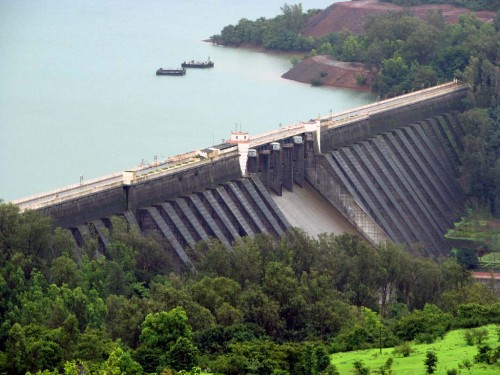
Koyana Dam that diverts water from Krishna basin to Konkan
photos of koyna water being wasted into arabian sea via konkan

...............................................................................................................................
photos of koyna water being wasted into arabian sea via konkan
...............................................................................................................................
S.A.N.D.R.P.
South Asia Network on Dams, Rivers and People
Open Letter to Chief Minister of Maharashtra: Stop Westwards diversion of water from Krishna basin
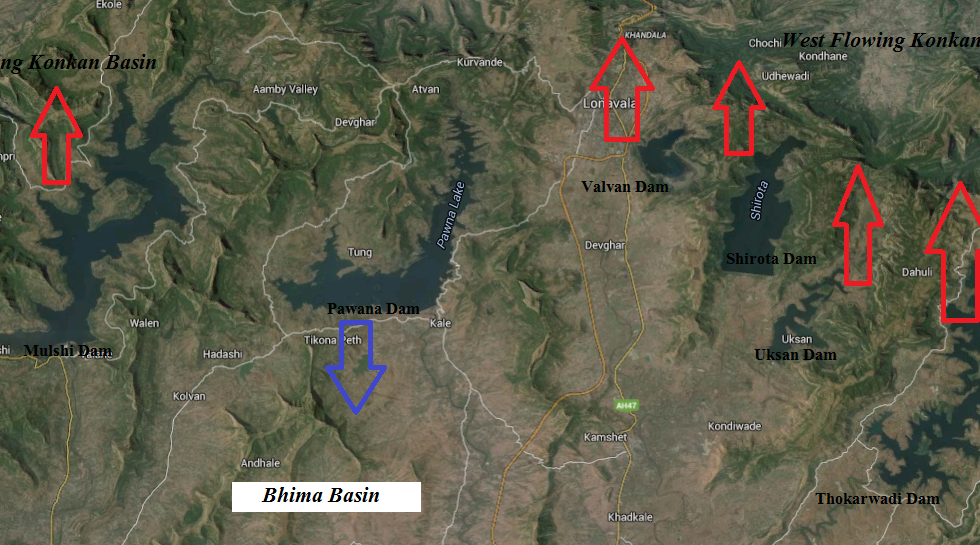
OPEN LETTER TO HON. CHIEF MINISTER OF MAHARASHTRA:
Water Diversion from Krishna basin by Koyna and Tata Dams:
Maharashtra is violating Human Rights, National & State Water Policy
August 18, 2015
Dear Shri Devendra Fadnavis,
As we all
know, large parts of Maharashtra, including Marathawada and Western
Maharashtra (part of IMD division called Madhya Maharashtra) are in the
grip of biggest monsoon deficit in the country with deficits of 48% and
33% respectively at the end of August 17, 2015 as per IMD[1]. Even beyond the state border, North Interior Karnataka has monsoon deficit of 45%, Rayalseema 36% and Telangana 23%.
Farmers in
all these regions are in distress, rainfed Kharif crop, the only crop
for most of them, may have been jeopardised for almost all of them. Most
of the reservoirs have paltry storages, the biggest in the Krishna
basin, Ujani in Maharashtra and Nagarjunsagar in Telangana (also
catering to parts of Andhra Pradesh) have zero % in live storage,
Srisailam has paltry 9%[2]. Millions of farmers and people are facing the prospects of livelihood loss and severe water scarcity.
While the
situation is this serious in Krishna River Basin and adjoining basins,
in Maharashtra, huge amounts of water is being diverted from the Krishna
basin to the water surplus Konkan region which has seen close to 1600
mm rainfall already. This westward diversion of water from the east
flowing Krishna-Bhima basin ultimately takes the water to Arabian Sea,
while the Krishna basin, which should have the first right over this
water, remains plunged in massive water scarcity. Krishna basin is thus
being deprived of its water.

Koyana Tail Race Water meeting Vashisthi River in Konkan on way to sea (Photo by Parineeta Dandekar 14 Aug 2015)

Koyana Tail Race Water flowing into Vashisthi River in Konkan on way to sea (Photo by Parineeta Dandekar 14 Aug 2015)
Koyna and Tata Dams in Maharashtra
The westward diversion of water from Krishna basin to Konkan and
further to sea is happening through the four stage Koyna Dam with total
installed capacity of 1920 MW[3].
These projects, as per the daily reports of Maharashtra Load Despatch
Centre, generated 291.33 Million Units (MU) of power between July 1 and
Aug 17, 2015. As per Krishna Water Disputes Tribunal Award, Koyna is
annually diverting 1911 MCM (Million Cubic Meters) of Water. So assuming
proportionate diversion, Koyna project would have diverted 187.14 MCM
during July 1 to Aug 17[4].
Similarly
the three Tata Hydropower stations (Khopoli, Bhivpuri and Bhira) with
total installed capacity of 297 MW generated 156.66 MU of power during
July 1 to Aug 17, 2015 as per daily generation reports of Maharashtra
Load Despatch Centre. As per KWDT award, Tata projects divert 1413 MCM
of water annually, so in the period under review, they are likely to
have diverted at least 180.11 MCM on pro rata basis calculation.
So
between July 1, 2015 and Aug 17, 2015, Koyna and Tata dams have diverted
about 367.25 MCM of water FROM Krishna basin to water surplus Konkan
region and down to sea. As we had noted earlier[5],
the indications were already available in early July that these regions
were facing massive rainfall deficit, crop failures and water scarcity.
Available water These projects also have substantial water storage today[6].
Koyna dam has 2095 MCM water, which is 74% of its capacity and Tata
dams (Mulshi, Andhra, Walwand, Shirawate and Lonavala) have 620 MCM
water, which is 55% of their storage capacity, compared to Ujani dam and
Nagarjunsagar Dams, which have ZERO water and Srisailam has 9% in live
storage.
The
collective amount of 2715 MCM of live storage water in Koyna and Tata
dams can be easily released into the Bhima-Krishna basins and this can
benefit the whole of Krishna River Basin, right till the tail end in
Krishna Delta.
Residents of
the Krishna Basin have the first natural right over this water, but
this massive 2715 MCM water is not to be released for the Krishna basin,
but is slated to flow to water surplus Konkan and down to sea. This is
when the whole Krishna basin is facing severe water scarcity.
Sir, the
westward diversion of 367.25 MCM water from Krishna basin during July 1
to Aug 17, 2015 by these dams could have been avoided if Maharashtra
government had taken timely action. Even now the 2715 MCM water stored
in these dams can be released for the rightful use of the people in
Bhima and Krishna basin if the Maharashtra government were to take
action immediately.
Sir, by not
taking this action, Maharashtra government is depriving the residents of
Krishna basin from rightful use of the water of the Krishna basin.
Maharashtra government is thus not only violating the National and
Maharashtra State Water Policy & MWRRA Act, but also Human Rights
and Right to life of the people of Krishna basin. This water can help
the critically parched Marathwada too through pipeline supply to
Osmanabad and Latur and also peripheral areas though the Seen Madha Link
Tunnel.
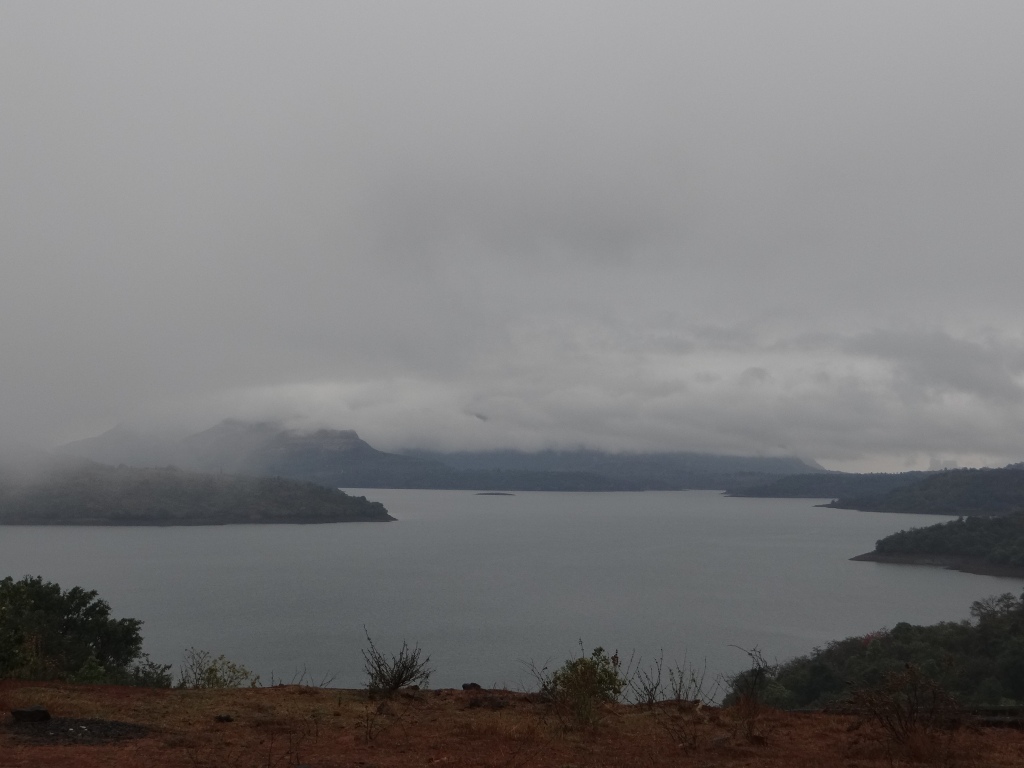
The
huge Mulshi reservoir with Designed Live Storage of 553 MCM, higher
than Panshet/Varasgaon/ Chaskaman/Dimbhe or Neera Deoghar Photo:
Parineeta Dandekar
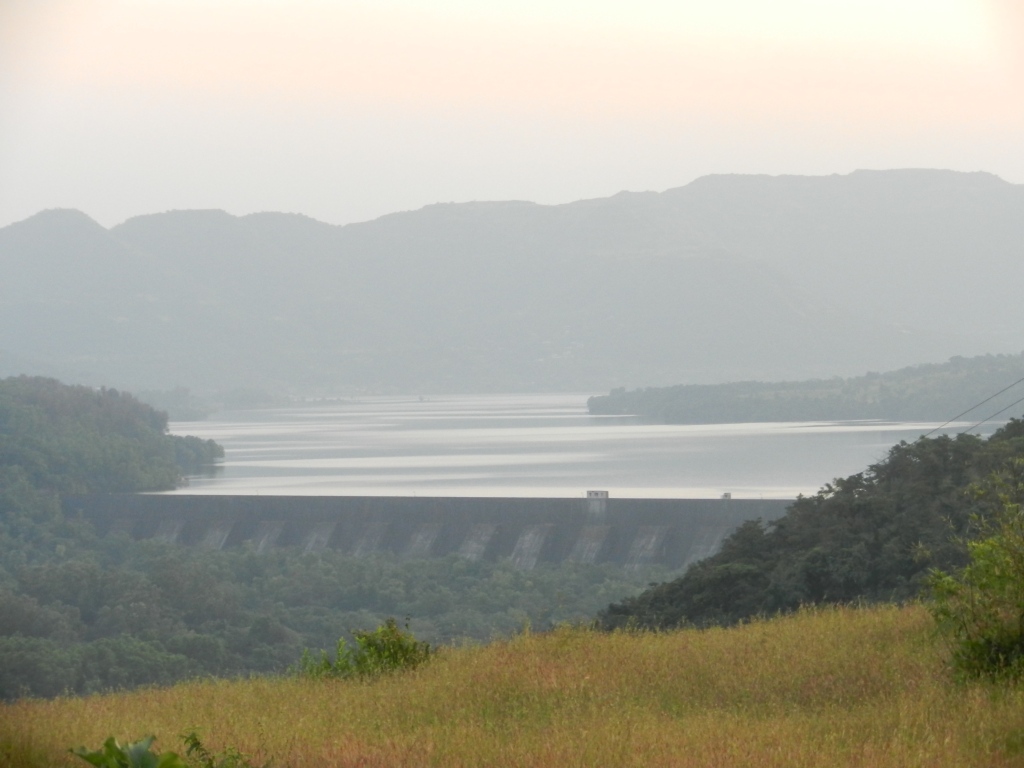
The
huge Mulshi reservoir with Designed Live Storage of 553 MCM, higher
than Panshet/Varasgaon/ Chaskaman/Dimbhe or Neera Deoghar Photo:
Parineeta Dandekar
Why Maharashtra can afford to forgo loss of power if westward diversion is stopped:
While
stoppage of such diverion by Koyna and Tata dams will entail some loss
in power generation, it needs to be remembered that power generation is a
lower priority in National and Maharashtra State Water policy compared
to drinking water and agriculture water use.
So you will
only be following the National and state policies and laws by directing
stoppage of water diversion from drought affected Krishna basin.
Secondly,
much more power is being generated today by alternative sources like
wind and solar today in Maharashtra and elsewhere. For example, during
July 1 to Aug 17, while these dams generated 447.99 MU (Million Units)
of power, Wind and Solar power generation was almost four times more in
Maharashtra alone at 1647.32 MU.
Thirdly, all over India, today power generation capacity is outstripping the power demand, so there is insufficient offtake of power generated,
so much so that plant load factors of Thermal Power Plants have gone
down below 60% and some say below 50%, from highs of 75-85%. The prices
of power traded at power exchanges have come down to below Rs 2.5 per
unit and substantial power is going unused for the lack of demand or
transmission capacity.
In such a
situation, Maharashtra can certainly afford to forgo some power
geneation from these dams, in the interest of rightful water use in
Krishna basin for the drought hit farmers and others in the state and
the basin.
Electricity Act 2003 supports stoppage of such generation during Natural Calamity Fourthly, the section 11 of the Electricity Act of 2003 gives
legal powers to the government to change the operation of any power
project in response to various situations, which includes “Natural
calamity”. Severe drought indeed qualifies as Natural calamity.
The government can stop diversion of water by Tata & Koyna dams
from the Krishna-Bhima basin using this legal provision.
Violation of National Water Policy The
National Water Policy 2012 says: “Safe Water for drinking and
sanitation should be considered as pre-emptive needs, followed by high
priority allocation for other basic domestic needs (including needs of
animals), achieving food security, supporting sustenance agriculture and minimum eco-system needs.
Available water, after meeting the above needs, should be allocated in a
manner to promote its conservation and efficient use.” (Emphasis
added.)
It is clear
that use of water for “achieving food security, supporting sustenance
agriculture and minimum eco-system needs” has higher priority compared
to other uses including power generation as per National Water Policy.
By not stopping westward diversion, sir, you will be violating NWP 2012
as also the state water policy and Maharashtra Water Resources
Regulation Authority Act of 2005.
Violation of Human Rights and Right to life
The westward diversion of Krishna basin water to Konkan and sea, while
people in the Krishna basin are suffering drought, crop loss, loss of
livelihood and water scarcity, is also violation of Human Rights and
Right to life for the people of Krishna basin. We hope, sir, you will
reverse this and stop this westward diversion.
Former Union Minister for Agriculture Sharad Pawar recently toured Marathwada to understand the drought scenario[7]
and in his address talked about “diverting west flowing rivers to the
east for Marathwada.” Before attempting anything like that, we can
simply secure that east flowing rivers flow to the east, at least in
drought situations!
Tata Power responds without sensitivity or application of mind
Sir, while Maharashtra government and Koyna dam authorities did not
respond to our earlier press release of Aug 7, 2015 on this subject,
Tata Power did, following front page story in DNA newspaper on Aug 9,
2015. We appreciate the response from Tata Power, but as we have noted[8],
this response is without application of mind or sensitity towards
suffering people of Krishna basin, whose water Tata Power is diverting.
In conclusion
Sir,
in view of the above, it is clear that the first right over use of the
2715 MCM of water now available in Koyna and Tata dams (and more that
will flow into these dams in the remaining part of this year) is that of
the people of Krishna basin.
This water
is currently slated to be diverted out of the drought affected Krishna
basin. It is technically feasible to release this water into the Krishna
basin rather than diverting Konkan and then to sea. Such release and
stoppage of westward diversion would be according to the National and
State Water Policies, MWRRA Act, Human Rights and Right to Life of the
people Krishna basin.
There will
be power loss in such stoppage of westward water diversion, but under
current power situation in the state and the country, it should be
possible to bear this loss without too much impact. Perhaps the costs of
drought mitigation, tanker and train deployment, etc, would be
comparable with this cost. Electricity Act 2003 also supports such
stoppage during Natural Calamity.
We
hope all this is sufficient for you to take urgent action and direct
urgent release of this water to the Krishna basin from Koyna and Tata
Dams and also direct stoppage of westward diversion from Krishna-Bhima
basins.
The water
released by these dams can be taken used across the basin in multiple
ways in the interest of the drought affected farmers and others. For
example water released from Tata dams could flow to Ujani dam (which is
at Negative Storage or below the zero live storage level currently) and
from there can be used in the basin. It can be taken to Beed and
Osmanabad in Marathwada through pipelines already in place for drinking
water supply. Through the Bhima-Seena Link Tunnel, it can flow into
Seena River and can be used by bordering parts of Marathwada and Solapur
District for drinking water, provided it is possible to ensure that it
does not get used up for sugarcane and sugar factories and such other
non essential water use activities.
Very strict
restrictions on the proper use of this water based on priorities of
drinking water and livelihood agriculture have to be maintained.
Sir, people of Maharashtra and India will look forward to your response on this issue.
Thanking you,
Yours Sincerely,
Parineeta Dandekar (Pune) and Himanshu Thakkar (Delhi)
END NOTES:
[1] http://www.imd.gov.in/section/nhac/dynamic/Monsoon_frame.htm as on August 18, 2015 at 11 hours.[2] See the latest CWC reservoir bulletin of Aug 13, 2015: http://59.180.242.253:83/DocumentUploadRoot/DocumentId_3519/BULL_13.08.15.pdf
[3] https://sandrp.wordpress.com/2015/08/07/as-krishna-bhima-basin-farmers-in-maharashtra-karnataka-ap-telangana-face-drought-crop-failure-water-scarcity-maharashtra-diverted-350-mcm-water-from-the-basin-literally-to-sea/
[4] http://mahasldc.in/wp-content/reports/dr0_17082015.pdf and http://mahasldc.in/wp-content/reports/dr0_31072015.pdf
[5] https://sandrp.wordpress.com/2015/07/14/six-regions-of-india-facing-prospects-of-crop-failure-and-drought/
[6] https://wrd.maharashtra.gov.in/
[7] http://www.dnaindia.com/india/report-ncp-chief-sharad-pawar-to-meet-pm-modi-fm-arun-jaitley-over-farmers-loans-2115146, for more details, see: https://sandrp.wordpress.com/2015/08/18/drought-and-marathwada-an-oft-repeated-tragedy/
[8] https://sandrp.wordpress.com/2015/08/17/tata-power-responds-on-the-issue-of-tata-dams-diverting-water-from-drought-hit-bhima-krishna-basin-to-konkan-but-it-is-vacuous-insensitive-response/
7 Comments on “Open Letter to Chief Minister of Maharashtra: Stop Westwards diversion of water from Krishna basin”
Leave a Reply
..................................................................................................................................
BMC project to ensure city gets water from Koyna dam - DNA
www.dnaindia.com › Mumbai
Feb 2, 2011 - According to the state government's plan, the project would cost about Rs40,000 crore. ... There is no scope to divert the water to nearby parts for irrigation or other purposes because of ... Six lakes in and around Mumbai supply water to the city. ... The project is expected to bring 1,200mld water to the city.
Aug 19, 2013 - Hinting that the project to bring water from Koyna dam to Mumbai was ... materialise and water supply from them is operational, there will be no ...
BMC drops plan to source Koyna dam water | mumbai ...
www.hindustantimes.com/mumbai/...plan...koyna...water/story-aAvCkEe...
Water: Present tense, future perfect - Afternoon DC
www.afternoondc.in › Diary
Maharashtra govt to take up ambitious water grid project to ...
indianexpress.com › cities › mumbai
PLEASE GIVE THINKING BRAINS TO NETAS OF THIS COUNTRY TO BENEFIT THE COMMON MAN
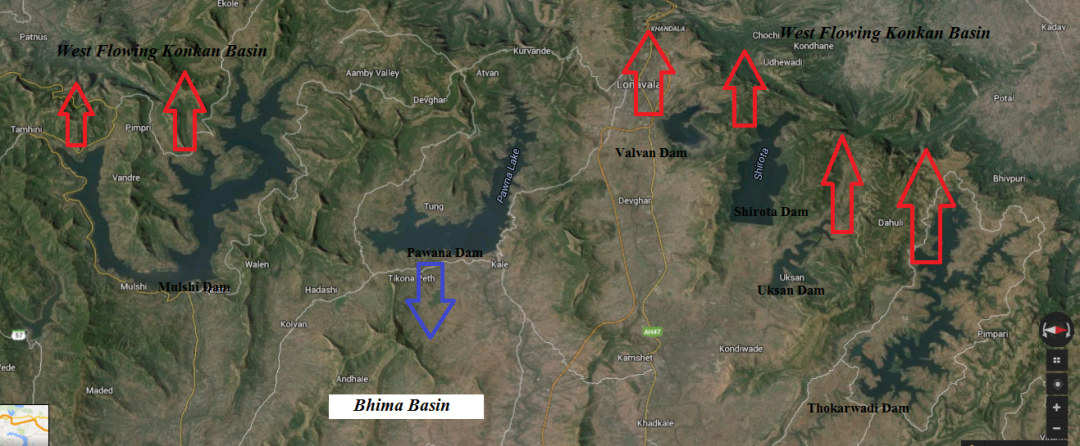
You could also start a petition on Avaaz.org. It might help in getting rapid attention to this issue.
These units can be used to store/conserve electricity when the electricity grid has surplus power by running the units as pumps to lift the water in to upper reservoir (Koyna & Mulshi dams). When the grid is facing power shortages, this water can be used for generating power from the stored water by releasing in to lower reservoirs (Konkan rivers). Thus there is no water loss from the Krishna basin water to Konkan region rivers. Nominal water water required for reservoir evaporation losses can be met/pumped from the Konkan region coastal rivers. In case of severe shotage of water in Krishna basin (similar to this year), The pumping features of these hydro stations can be very well used to augment water in the Krishna basin from the coastal rivers of the Konkan region.
The nearby NTPC Ratnagiri gas power project (2000 MW) is not working for more than a year due to shortage in natural gas availability and it has a Liquefied Natural Gas (LNG) import facility to supply re-gassified LNG to this power station. Now LNG is available in international spot market around US$ 6 per mmbtu which can produce elecricity from gas based power projects more economical to the power produced from coal fired power stations with imported coal. The LNG prices have fallen to one third of earlier high prices. Though Maharashtra is having binding PPA for this power station it is not honouring the PPA by drawing power from this power plant. Presently, Maharashtra is purchasing power regularly from many power stations which are using imported coal.
It would be productive preposition that central/ Maharashtra govt. would run the Koyna & Tata hydro power stations strictly in pumped storage mode (without consuming water from Krishna basin) to meet the peaking shortage in the national grid @ 2100 MW and consume the surplus electricity from the grid @ 1150 MW during rest of the duration (i.e. surplus duration). Near by NTPC Ratnagiri gas power project (2000 MW) may augment the base load power for the pumping operation of the these hydro stations for their full capacity utilisation throughout the year.
Thus Krishna river water can be fully utilised in Krishna basin and Maratwada region for drinking / essential needs with overall value addition from these assets and the water resource to the Maharashtra state/the nation.
Mr. Pawar has been batting for the entirely unfeasible diversion of west flowing rivers into Marathwada for a long time. In fact there is some diversion already happening in Nashik from the Damanganga Basin, which is promptly used up in Nashik itself. No question of Marathwada
thanks,
parineeta
Must read for @PMOIndia @TelanganaCMO @AndhraPradeshCM @CMofKarnataka @umasribharti
Kudos to Parineeta Dandekar (Pune) and Himanshu Thakkar (Delhi)
God Bless you for Educating Indians about precious Natural Resource Water being wasted and sent to sea with short sight of Maharashtra State Leadership